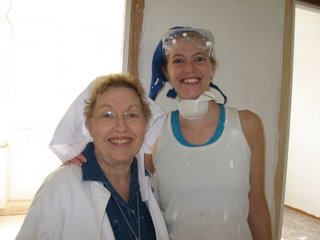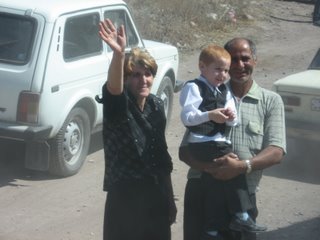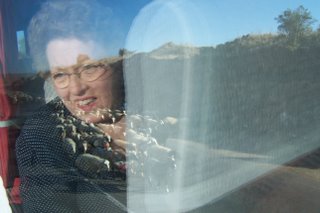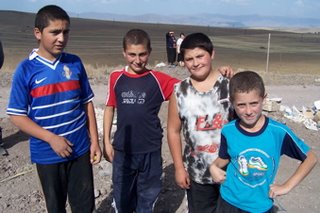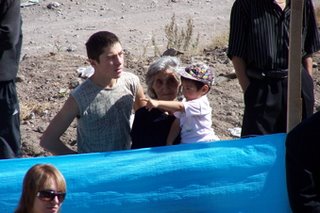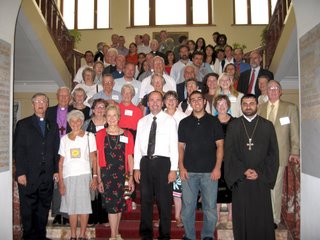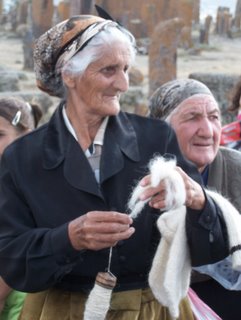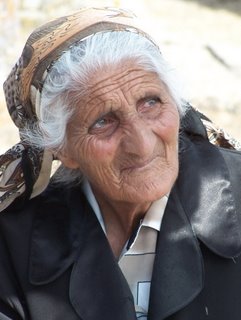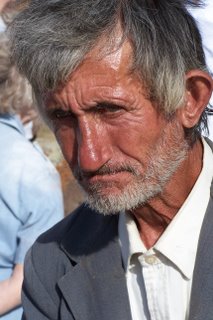Saturday, January 27, 2007
Wednesday, October 11, 2006
Changing Hearts and Minds Through Service
A reflection on my Habitat for Humanity trip to Armenia
This month I had the opportunity to travel to Armenia with the National Council of Churches on a Habitat for Humanity International build. This small, landlocked country is surrounded by Iran, Turkey and Azerbaijan, putting it in a less than stable region – and one which does not always view Americans in a positive light. However, in the small town of Gavar, where the Habitat build site was located, we were greeted every day with warmth and love. The children performed songs and dances for us, the local monks and bishops joined the build, the townspeople came to watch and the families receiving the homes stood side-by-side with us as we painted, sanded and tiled the new homes. In a country with a poverty rate of over 45%, where many small towns have no indoor plumbing or electricity, our presence brought hope for a brighter future. And we served as a small reminder of how as they are not alone as they struggle to rebuild their economy.
As I thought about this reaction of friendship, it also made me think of how other Americans are being greeted with anger and distrust across this world, especially by Armenia’s neighbors in the Middle East. In a time when the United States is best known for our “shock and awe” tactics, it causes me to pause and think about what would happen if we took another route to spread Democracy – instead of bombing buildings, we could support infrastructure. Instead of sending innocent civilians to the hospitals when they are caught in the cross-fire, we could stand beside them to build the hospitals. And – most importantly – while helping with humanitarian projects, we could help build hope and trust with a group of people who currently view us with anger and distrust.
It’s easy to react with anger and lash out when you are seeing your friends and family killed by a civil war that you blame on America, walk through streets that are marred by the burn marks of car bombs or your stores are wrecked from looting. But what if, instead of seeing soldiers driving by in tanks, you saw your children going to a school that was built with the help of the Americans? Or you knew that the immunizations that your baby just received were thanks to a donation from our government? It’s easy to hate when you see only destruction. It’s much harder to hate when you see the product of our love and friendship.
This is not to say that we do not need a military or to protect ourselves. But how great it would be if we were able to change our paradigm of how to interact with our world community. What if, at the same time that we support Israel’s ability to protect themselves, we work hand-in-hand with Palestinian teenagers to build up their infrastructure, providing them an honest living and job skills? Or we hire Iraqi men and women to work with us to clean out bombed out buildings and refurbish them into clinics? The possibilities for positive collaboration are endless.
If you want to end conflict, it cannot be through war alone. It must also be through providing opportunities for families to live in dignity – with access to a safe home, food and honest work. We saw how the homes of Habitat for Humanity transformed the lives of the families who received them – and their appreciation for the people of the many countries that came together for the project. And I imagine what would happen if everyone could see us in that light.
As the United States looks at our future interactions with countries who pose a threat, I hope that we look not just at subduing them but aiding them as well. We must lead by example if we want to bring about a more peaceful world. That’s how we truly change the heart and mind of a country.
Tuesday, October 10, 2006
More Habitat Photos!
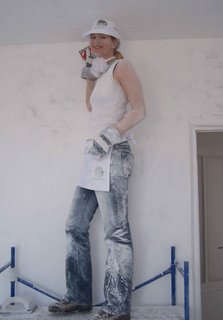 Yep, that's me - covered in paint and primer dust!
Yep, that's me - covered in paint and primer dust!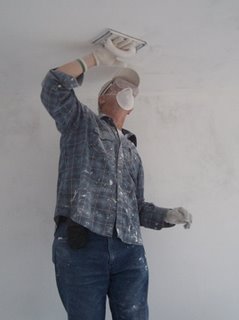 Rev. Bob Edgar primes the ceiling - like he always seeme dto be doing.
Rev. Bob Edgar primes the ceiling - like he always seeme dto be doing.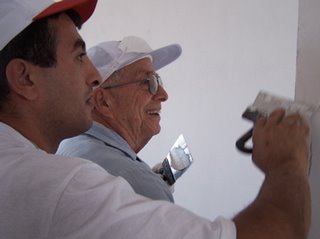 Our Armenian house leader, Vardan, shows Jim how to add spackle.
Our Armenian house leader, Vardan, shows Jim how to add spackle.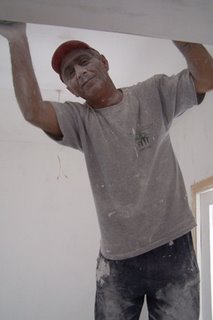 The other Vardan, the homeowner, works on priming.
The other Vardan, the homeowner, works on priming.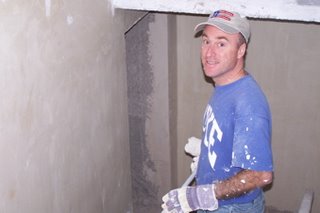 Rev. Markay rolls on the paint.
Rev. Markay rolls on the paint. This is what it looked like before the paint coats!
This is what it looked like before the paint coats! Everyone gets in on painting the railings.
Everyone gets in on painting the railings.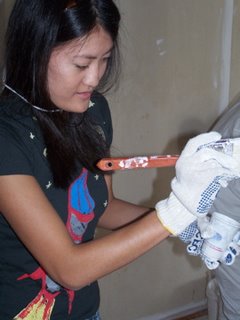 One of our team paints the door frame.
One of our team paints the door frame. Virginia takes a much needed break.
Virginia takes a much needed break.The Habitat Families
The complex where we worked in Armenia had 24 units in it. All 24 units were to be occupied by families who were chosen through the Habitat process. (See earlier post for more information on this). Each family had a unique story that touched your heart.
Our family, Vardan, his wife, sister and young daughter, were looking to have their first real home. They had been renting a sub-standard apartment unit. Vardan's eyes lit up when he looked around our unit, thinking of the life they would build.
Here are a few other stories about the homeowners who would be moving into their homes that we worked on.
Armenian Build on Faith: Meet the Families
FROM THE HABITAT WEBSITE: Catholicos Karekin II Work Project kicked off on September 5th 2006 in Gavar, Armenia. During the week-long blitz-build event, 24 homes will be built for as many families in need. Here you can read about people who will benefit from this unique building on faith event in Armenia.
The Dvoyan family: Sevak (31), Marine (22), Vahe

Marine Dvoyan with her three-month old son at the site of their future home in Gavar.
The Dvoyan family lived with Sevak’s brother and parents in a two-room flat. He married a year ago and, as he is the eldest son of the family, he soon had to leave the parents’ home to the youngest brother, according to the Armenian tradition. He earns US$230 a month working as an assistant at the health ministry.
“Thanks to Habitat Armenia and all its supports that did not allow my family to experience the feeling of homelessness, which I see in the eyes of my neighbors. This feeling makes people live like hermits. I appreciate you letting me feel the happiness of a homeowner and enabling me to care for the future of my children.
I have a son but now I am sure that my son will have a sister or a brother. And this is only due to your help and support. Thank you.” Sevak said.
The Gasparyan family: Armen (35), Margarit (32), Sima, Roland, Daniel, Rebeka, Esterdiv

The Gasparyans sold their house to help Armen’s brother pay off debt. The family was certain that they could get a new house very soon. In reality, with a monthly salary of US$200 working as a welder, Armen was hard-pressed to cover the family’s expenses, let alone buy a house.
The family rented a place to live for more than 10 years. Armen worked days and nights to save for a home. Unfortunately, the eldest son Roland became ill and they had to spend a lot on his treatment and medicines. The family savings went down the drain. Armen and Margarit have difficulties expressing their about living in a place that they know is both unsafe and unhealthy for their children. Fortunately, the family will have a fresh start as they are selected to partner with Habitat Armenia in Gavar.
The Gharabaghcyan family: Karine (42), Lusine, Lianna, Babken, Siranush, Tamara

Karine is a single mother with five children. Eight years ago, her husband left her and Armenia to live abroad. She had to move to her parents’ home where her brothers live with their families.
She earns US$45 a month as the director of a kindergarten. Today her two elder daughters Lusine and Lianna are also earning US$30 and US$100 a month. One works in the Gavar library, the other in a taxi service.
“It is very difficult to live without a roof above our heads, in the open air, trying to protect my children from the cold, weather and illnesses. We lost everything, not only the happiness of the family. In spring, we began to live a new life when we started working on our new house. I am sure this house will bring more and more joy to our hearts and we will find our happiness there. Thank you for all your support,” said Karine.
The Pokrikyan family: Khachatur (49), Gayane (46), Gohar, Vardan

The Pokrikyans have been waiting for their house for 14 years. Khachatur and Gayane got married in 1987. Khachatur was the eldest son of the family of five: mother, father, two brothers and a sister. According to the Armenian tradition, the youngest son inherits the house of the parents. Gayane and Khachatur realized that soon they would have to leave the house. But they were sure that they would get a house in the newly built district of their town.
By 1989, their children were already born. The family used to walk with the children and always passed near the construction site of their future apartment, dreaming and telling the kids how beautiful it would be, what a nice playground they would have. In 1993, all the construction work was stopped. Khachatur’s younger brohther got married and so he head to rent a house and muster his strength to wait. “Whenever our children saw a half-built house, they asked if it should be our house; how long we still need to wait for it?” said Gayane.
In 2006, the Pokrikyans were selected to be a Habitat Armenia homeowner. “We were dreaming of an affordable place for our children, but today our son is building a house for us. To have a house and to be sure that you are not living as a guest is one of the happiest moments in life,” said Gayane. Thanks to you all for helping us to make our dream come true!”
Friday, October 06, 2006
Wednesday, September 27, 2006
Dr. Rev. Bob Edgar's "Huffington Post" Blog
Check it out - and leave him a commnet if you have the time.
Saturday, September 23, 2006
Khachkars (pronounced: kosh - cars)
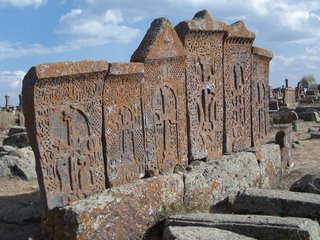
One afternoon, after working on the homes, we stopped by Noratus, which is at the western shore of the Lake Sevan. It was one of those evenings when we were all pretty tired from a long day of painting and sanding. I know that I was thinking, as we drove along in our bus, that I would almost rather skip the sightseeing and just go back to the hotel.
However, we stopped and, like dutiful students, we trooped out of the bus and up the hill to the cemetery. And I'm so glad we did. What we found was a cemetery with over 900 "khachkars", which are carved stones. Usually they were erected to honor someone's death, but there are also khachkars that memorialize a war or act as a form of protection from natural disaster.
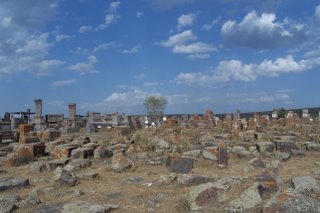
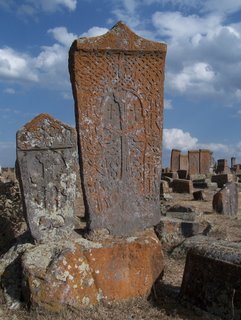
It was amazing walking amongst these stones, knowing that some were made over 1,000 years ago.
Even more interesting were a few of the villagers who were up there as well. As we walked towards the cemetery three very old women approached us with sox to sell. The sheep were all around them, and one women was knitting in front of us - using what must have been recently sheered wool from her flock.


Also, a group of children followed us and gave us little flowers. I asked our guide if they were looking for money, but she said that they weren't - they were just giving us small gifts. A few of them were learning English in school, and practiced on us. "What is your name?" they would say. We would respond with our names and ask them, which they would in turn tell us. Then they would ask, "how are you?" These were the only phrases they knew - but it was cute hearing them practice.
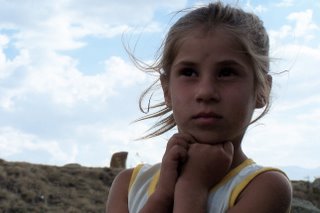
We stayed for about 20 minutes, learning about the various styles of khachkars throughout the ages and examining the stones. It was another one of so many moments when I was reminded that I was far, far away from the United States. And I was in awe of the history and age of what surrounded me.


Thursday, September 21, 2006
Fun Pictures from Sandy Bensen
